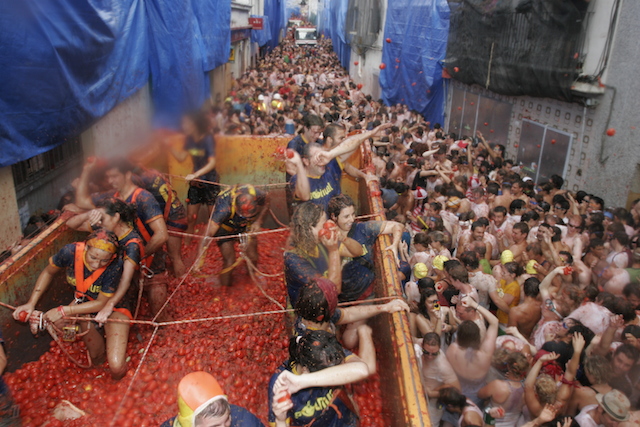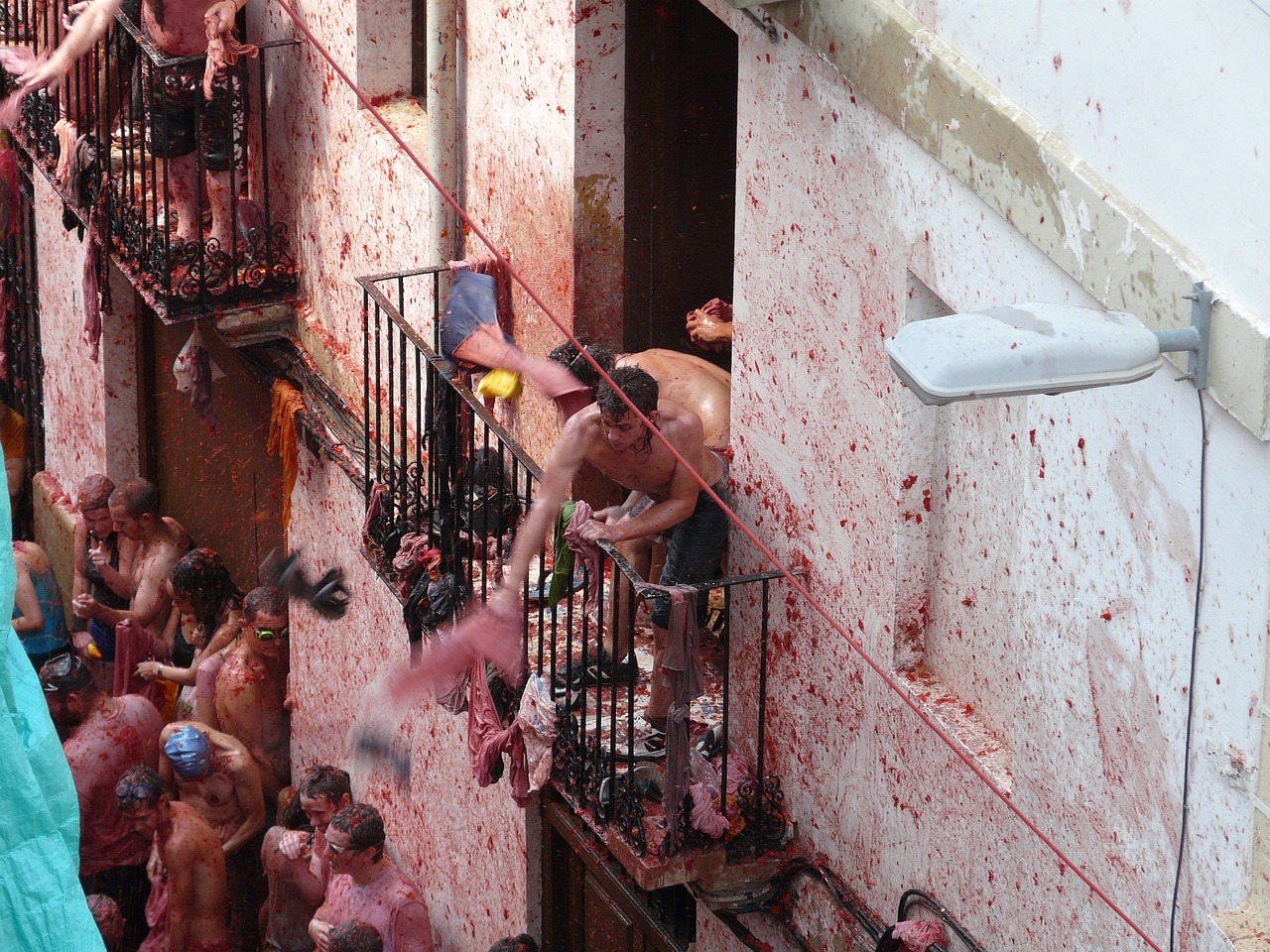Introduction
Every year, on the last Wednesday of August, the streets of Buñol, a small town in the Valencia region of Spain, turn red. But it’s not from paint or any artificial dye. It’s from tomatoes. Thousands upon thousands of ripe tomatoes are thrown, squashed, and smeared in what has become one of the world’s most unique and exhilarating festivals: La Tomatina.
La Tomatina is not just a tomato fight; it’s a celebration of joy, a nod to the absurd, and a testament to the Spanish spirit of festivity. For many, it’s a bucket-list event, a chance to participate in a tradition that has no parallel anywhere else in the world.
Buñol, with its picturesque streets and Mediterranean charm, might seem like an unlikely place for such a raucous event. Yet, once a year, this town, which is usually quiet and unassuming, becomes the epicenter of a tomato-throwing frenzy. Its inhabitants, along with thousands of visitors from around the world, come together in a united, albeit messy, celebration. The heart of the tomato battle beats strongly here, echoing the rhythms of Spanish passion and exuberance.
For those looking to dive deeper into the history, significance, and sheer fun of this event, the official website of La Tomatina (www.latomatina.info) offers a wealth of information, from ticketing details to guidelines on how to make the most of the experience.

History of La Tomatina
The streets of Buñol awash in a sea of red, jubilant faces smeared with tomato pulp, and the air filled with laughter and shouts. This is the modern-day scene of La Tomatina. But how did this tomato-throwing frenzy come to be? Let’s delve into the history.
Origins and legends
The true origins of La Tomatina are somewhat shrouded in mystery, with various tales and legends associated with its inception. One popular story dates back to 1945 when, during a local festival, a group of young people wanted to participate in a parade with musicians. In the ensuing scuffle, a vegetable stall was knocked over, leading to an impromptu tomato fight. The following year, the same group decided to repeat the tomato fight, bringing their own tomatoes, and thus a tradition was born.
Another legend suggests that the tomato fight began as a form of protest against the town’s councilmen. Yet another tale speaks of a tomato fight between friends that spiraled into a town-wide event.
Regardless of its true beginnings, what’s clear is that the event was so memorable and enjoyable that the townspeople decided to repeat it year after year.
Evolution over the years
Initially, La Tomatina was not always met with enthusiasm by the authorities. In its early years, it was banned several times due to concerns about safety and public disorder. However, the people’s love for the event was undeniable. In 1957, after a mock tomato funeral procession was held in protest of the ban, the festival was reinstated and has been celebrated ever since.
Over the decades, the event has grown in scale and popularity. What began as a local festivity is now an international phenomenon, drawing tourists from all corners of the globe. In 2002, the Spanish Secretary of Tourism declared La Tomatina a Festivity of International Tourist Interest, further cementing its place in the global cultural calendar.
Today, with certain rules in place to ensure safety (like squashing the tomatoes before throwing to avoid injuries), the festival continues to be a testament to the joy, unity, and spirited nature of the Spanish people.
For more details on the event’s history and its significance, the official Buñol Town Hall website (www.bunol.es) offers a comprehensive look into this unique celebration.
The event: a step-by-step guide
La Tomatina is not just a tomato fight; it’s a culmination of traditions, festivities, and rituals that make it a unique experience. Let’s walk through the event, step by step, to ensure you make the most of this vibrant celebration.
Pre-Tomatina festivities
The week leading up to the main event is filled with parades, concerts, and firework displays. The streets of Buñol come alive with color and music, setting the stage for the tomato battle. One of the most anticipated events is the “palo jamón,” a greasy pole with a ham at the top. Brave souls attempt to climb this pole and grab the ham, all while spectators cheer them on, often dousing them with water from their balconies.
The main event: rules and rituals
While it might seem like pure chaos, there are some essential rules and rituals to be aware of:
- Safety First: Tomatoes must be squashed before throwing to prevent injuries.
- Only tomatoes can be thrown – no other objects.
- Participants should wear old clothes – they will get messy!
- It’s advisable to wear protective eyewear and gloves.
- The battle starts when a cannon is fired, signaling the arrival of trucks loaded with tomatoes. It ends an hour later with another cannon shot.
During the event, the streets of Buñol turn into rivers of tomato pulp. Participants, locals, and tourists alike join in the fun, throwing tomatoes and getting drenched in the process.

Post-Tomatina: cleaning up and continuing the celebration
Once the final cannon is fired, the tomato throwing stops. The town’s fire brigade then begins the task of cleaning the streets with water hoses. Remarkably, due to the acidity of the tomatoes, the cobblestone streets of Buñol end up cleaner than before!
Participants can also get cleaned up at designated spots or by the locals, who often offer hose-downs to the tomato-covered revelers.
The celebration doesn’t end with the cleanup. Post-Tomatina, the town is abuzz with energy. Bars and restaurants are filled with people sharing their experiences, and impromptu street parties are a common sight. It’s a time to relax, enjoy the local gastronomy, and soak in the festive atmosphere.
For those looking to plan their trip and get more details on the event, the official Buñol Town Hall website (www.bunol.es) is a valuable resource.
Significance and cultural impact
La Tomatina is not just an event; it’s a reflection of Spain’s vibrant culture, its love for festivities, and its ability to turn the ordinary into something extraordinary. Let’s delve into the cultural significance of this unique festival and its global appeal.
La Tomatina in spanish culture
At its core, La Tomatina is a celebration of community. It’s a day when differences are set aside, and everyone, whether young or old, local or tourist, comes together for a joyous battle. The streets of Buñol, usually quiet and serene, transform into a playground, echoing with laughter and camaraderie.
The festival also represents the Spanish spirit of fiesta and tradición. Just like the running of the bulls in Pamplona or the flamenco dances of Andalusia, La Tomatina is a testament to Spain’s rich tapestry of traditions. It’s a day when the past meets the present, where age-old rituals are celebrated with modern fervor.
The global appeal and international recognition
Over the years, La Tomatina has transcended its local roots to become a global phenomenon. Thousands of tourists from around the world flock to Buñol every year, eager to participate in this one-of-a-kind event. Media outlets from every corner of the globe cover the festival, further amplifying its international appeal.
The global recognition of La Tomatina can be attributed to its universal theme of fun, freedom, and fraternity. It’s a festival that breaks barriers, where language or nationality doesn’t matter. All you need is a handful of tomatoes and a spirit of adventure.
Moreover, the festival has inspired similar events in countries like Colombia, Costa Rica, and even India, showcasing its universal appeal and the ability to bridge cultures.
For those interested in experiencing La Tomatina firsthand or learning more about its history and significance, the Buñol Tourism Office website (www.bunol.es/turismo) offers a wealth of information.
Practical information for tourists
For those eager to dive into the tomato-filled frenzy of La Tomatina, it’s essential to be well-prepared. This event is not just about hurling tomatoes; it’s about immersing oneself in a tradition that has been celebrated for decades. Here’s everything you need to know to make the most of this unique experience.
When and where: date, time, and location details
La Tomatina is held on the last Wednesday of August every year. The main event starts around 11 am, but the festivities begin much earlier, with parades and other events kicking off in the early morning.
The epicenter of the tomato battle is the town of Buñol, located about 30 kilometers west of Valencia. The main action happens in the town’s central streets, particularly around the Plaza del Pueblo.
Tickets and participation: how to join the fun
Due to the event’s immense popularity and to ensure safety, entry to La Tomatina is now ticketed. It’s crucial to buy your ticket in advance, as they often sell out quickly. Tickets can be purchased online through the official Buñol Town Hall website or authorized tour operators.
There are also special packages available that include transportation, guided tours, and even after-party access. Ensure you’re buying from a reputable source to avoid scams.
Recommendations: what to wear and bring
- Clothing: Wear old clothes that you don’t mind getting stained. Many participants opt for white shirts to showcase the tomato splatters fully. Closed shoes with a good grip are essential, as the streets become slippery.
- Protection: If you wear glasses, consider switching to contact lenses for the day. Goggles can also be a good idea to protect your eyes from tomato juice.
- Waterproofing: A waterproof bag or pouch can be handy to keep your belongings, like money and phone, safe and dry.
- Stay Hydrated: While there’s plenty of tomato juice to go around, remember to bring a bottle of water to stay hydrated.
- Respect the Rules: Only throw squashed tomatoes to avoid hurting anyone, and stop throwing when the second gunshot sounds.
For more detailed information, schedules, and ticket bookings, the Buñol Tourism Office website (www.bunol.es/turismo) is a valuable resource.

Environmental and sustainable aspects
In an era where sustainability and environmental consciousness are paramount, it’s essential to consider the impact of large-scale events like La Tomatina. While the festival is a symbol of joy and unity, it’s also a testament to the town of Buñol’s commitment to responsible celebration.
The Tomatoes: sourcing and environmental impact
The sheer number of tomatoes used in La Tomatina is staggering. Every year, over 150,000 tomatoes, weighing approximately 40 metric tons, are used in the event. These tomatoes are specially grown in Extremadura, a region in Spain, for the sole purpose of this festival. They are of a lower cost and quality, not suitable for consumption, ensuring that no food is wasted for the sake of the event.
However, the transportation and decomposition of these tomatoes do have an environmental footprint. The decomposition process, while natural, produces methane, a greenhouse gas. Additionally, transporting the tomatoes to Buñol consumes fuel and emits CO2.
Efforts towards sustainability and waste reduction
Recognizing the environmental concerns, the town of Buñol and the event organizers have taken several steps towards sustainability:
- Waste Management: Immediately after the event, the streets are cleaned using fire trucks, leaving them spotless. The acidic nature of the tomatoes acts as a disinfectant, leaving the streets cleaner than before. The tomato pulp is collected and processed, often used as compost or animal feed.
- Water Usage: Efforts are made to minimize water usage during the cleaning process. The town encourages participants to use public showers and promotes water conservation.
- Public Transportation: To reduce the carbon footprint of individual vehicles, participants are encouraged to use public transportation. Special trains and buses are arranged to accommodate the influx of visitors.
- Promotion of Local Economy: By sourcing tomatoes locally and promoting local businesses during the event, the town ensures economic benefits stay within the region, reducing the overall carbon footprint.
For those interested in the sustainability efforts and want to contribute, the Buñol Environmental Department (www.bunol.es/medioambiente) offers information and volunteer opportunities related to the event.
Other attractions in Buñol
While La Tomatina is undoubtedly the most internationally recognized event in Buñol, this charming town nestled in the Valencian countryside has much more to offer. Delving beyond the tomato-soaked streets, visitors will find a rich tapestry of culture, history, and gastronomy waiting to be explored.
Exploring beyond the tomato battle
- Buñol Castle: Dominating the town’s skyline, the Buñol Castle is a testament to the region’s rich history. With origins dating back to the 13th century, the castle offers panoramic views of the town and the surrounding countryside. The castle’s architecture is a blend of Moorish and Christian influences, reflecting the diverse history of the region.
- Natural Parks: Buñol is surrounded by natural beauty. The Parque Natural de la Sierra de las Cabrillas offers hiking trails that wind through picturesque landscapes, punctuated by waterfalls and lush greenery.
- Museo del Jamón: A tribute to one of Spain’s most iconic delicacies, this museum offers insights into the art of ham curing. Visitors can learn about the process and even sample some of the finest hams produced in the region.
Local gastronomy, landmarks, and festivals
- Gastronomy: Beyond tomatoes, Buñol boasts a rich culinary tradition. Local dishes like “olla podrida” (a hearty stew) and “gachas manchegas” (a type of porridge) are must-tries. The town is also known for its pastries, particularly the “borrachos,” a rum-soaked treat.
- Music Festivals: Buñol is renowned for its music, particularly its brass bands. The Mano a Mano festival sees two of the town’s most famous bands, the “Litro” and the “Carrascosa,” face off in a friendly competition.
- Medieval Market: Held annually, this market transforms Buñol’s streets into a scene from the Middle Ages. Artisans, performers, and food vendors come together to recreate the atmosphere of bygone days.
For those looking to plan their visit and explore all that Buñol has to offer, the Buñol Tourist Office (www.bunol.es/turismo) provides comprehensive information and resources.
Conclusion
La Tomatina is not just a festival; it’s a testament to the vibrant spirit and rich traditions of Spain. As the streets of Buñol transform into a sea of red, participants from all over the world come together, united by the sheer joy of the moment. It’s a celebration that transcends borders, languages, and cultures.
Reflecting on the unique experience of La Tomatina
The allure of La Tomatina lies in its spontaneity. There’s a raw, unbridled energy in the air as thousands gather, armed with tomatoes, ready to partake in a battle that’s fought in good spirits. The laughter, the camaraderie, the sheer thrill of being in the midst of the world’s largest tomato fight – it’s an experience that’s hard to put into words. It’s about letting go, embracing the moment, and becoming a part of a tradition that has captivated the hearts of many for decades.
But beyond the splatter and the fun, La Tomatina is a reflection of Spain’s soul. It embodies the nation’s love for life, its penchant for celebrations, and its ability to turn the ordinary into something truly extraordinary.
Invitation to immerse in the vibrant tradition of Spain
To those who have yet to experience the magic of La Tomatina, an invitation awaits. Come to Buñol, not just as a spectator, but as a participant. Dive into the heart of the celebration, let the tomatoes fly, and let the spirit of Spain wash over you. And as the final chime rings and the last tomato is thrown, you’ll leave with memories that last a lifetime and a piece of Spain forever etched in your heart.
For more information on La Tomatina and other Spanish traditions, the Spanish Tourism Board (www.spain.info) offers a wealth of resources to help you plan your next adventure.


